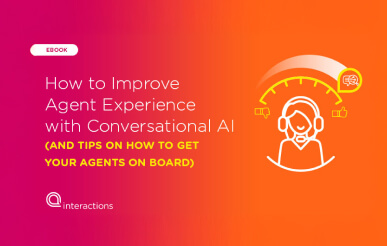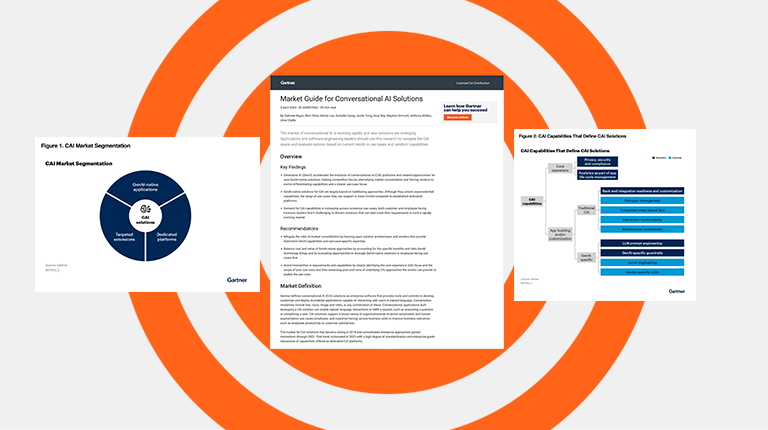Automated customer service has been identified as the number one use case for AI-enabled digital transformation by leading analysts like Tractica and IDC. More and more businesses are turning to Conversational AI applications, such as virtual assistants, that automate tasks while also bringing benefits like improved customer satisfaction, decreased costs, and increased revenue.
And businesses are experiencing another benefit of using Conversational AI solutions: improved agent experience. Virtual assistants can alleviate many agent pain points associated with contact center attrition including monotonous work and the pressure to keep up with the pace while maintaining numbers. Reducing or even eliminating these pain points, allows agents to focus on more challenging tasks and customers who might need more personal attention. This can make agents’ day-to-day work more interesting and can help them be and feel more productive. This improved experience can lead to happier agents and help reduce agent churn which can have a direct impact on the quality of your customer care.
However, despite the idea that virtual assistants are meant to work “side-by-side” with contact center agents and can improve their job experience, many agents fear that this type of automation will either put their jobs at risk or eliminate them completely. Therefore, when it comes to implementing a Conversational AI application, it is crucial that you keep your agents top-of-mind. By following these best practices you can ensure that your agents are not only aware of what is going on, but that they also feel part of the process, comfortable, and valued. This should start before implementation and continue throughout the life of your application. Using these best practices will help your agents understand the benefit of the solution to both your customer experience and to their agent experience.
1. Keep your agents updated with constant communication
This may seem simple and straightforward, but good communication is essential for any successful relationship. It is especially important in situations where new technology is being implemented to ensure there are no fears or misconceptions–especially around people’s jobs. Make sure you start communicating with your agents at the implementation stage so they are aware and in the know from the beginning. Be open and honest about how a virtual assistant will improve their work. Make sure to outline the benefits clearly so they know that this new technology is being implemented to help better support them in their role. The communications should come from one or two trusted point people, that way there is consistency in how the information is delivered and also someone to direct questions to.
2. Educate and train your agents
Education and training on your new Conversational AI application are just as essential as good communication. A good Conversational AI vendor will support you by putting together a series of educational events and training for your agents, so make sure to ask about this area when you are vetting your vendor. If your agents understand how the application works, then they will feel more confident receiving information and doing warm hand-offs. And remember, the key is continuous educating: as you add new business rules or expand capabilities to new channels, make sure your agents are fully trained and comfortable working with the technology.
3. Let your agents evaluate the technology
It is always important to get and give feedback in the workplace. And since your virtual assistant is essentially part of your team, the same goes for it. Since your agents will be working side-by-side with the application, they will be able to provide valuable insight into how everything is working. Listening to agent feedback can give great understanding into parts of the conversation design that can be improved, especially when the application is first launched. This will also make your agents feel more involved and invested in the technology.
4. Associate agent KPIs with the use of the application
Many businesses that are successful in getting their human agent and virtual assistant to work together do so by associating some of their agent KPIs with the use of the application. For example, the agent must learn to trust the information he receives from the virtual assistant and should not ask the customer to repeat that same information. Doing so would affect the efficiency of the interaction and the customer experience. Because virtual assistants can easily be integrated into systems like CRM, they can also bring valuable information to the conversation to help the agent provide a more personalized experience and be more efficient in helping the customer take care of his task. This information can also be helpful when the agent is upselling or cross-selling.
5. Let your agents shine
Your agents previously handled all types of tasks, but with a virtual assistant taking over the data-driven, complex, transactional conversations, now is your agents’ time to shine. They can now focus on tasks that need their expertise and special training. Give them kudos for helping with a particularly complex or emotional situation. Recognize them in front of their team as an example for these types of situations. In instances where there are opportunities for upselling and cross-selling, reward agents for achieving targets and goals.
It is important to remember that there may be sensitivity around AI coming into your agents’ territory. But, if you follow the best practices above and remind them that there will always be room for humans in the customer experience equation, you can set the stage for an improved experience for them. This can lead to a workforce that is invested in your brand for years to come.
Find out more ways that Conversational AI technology can complement your agents by downloading our free eBook How to Improve Agent Experience with Conversational AI.




